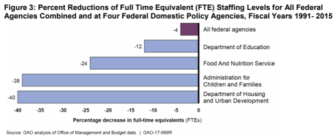
President Donald Trump came to Washington pledging to slash the federal workforce and drain the swamp. But he may be jumping on a train that’s already left the station, at least as far as the U.S. Department of Education is concerned.
Staffing at the department has dropped 36 percent over the past thirty-four years, from a high of 6,391 in federal fiscal year 1981, to 4,077 in fiscal year 2015, according to a report released Wednesday by the Government Accountability Office, Congress’ investigative arm. Those numbers measure full-time employee positions, which isn’t necessarily the same as the actual number of employees. However, over the same time period, which covers most of the department’s lifespan, contracting levels has remained relatively stable, the GAO found.
And fewer people hasn’t necessarily translated to less work. Over the same period that staffing levels dropped off dramatically, the total amount of spending the department is responsible for dealing with swelled, from $83 billion in fiscal year 1981 to a high of $145 billion in fiscal year 2009, which covered the American Recovery and Reinvestment Act, aka the stimulus. (Those figures aren’t the same as the department’s budget, because they include things like student loans.)
Importantly, the time period the GAO considered doesn’t cover any staffing reductions spurred by the Every Student Succeeds Act, which got rid of dozens of programs—some of which hadn’t been funded in years—and called on the feds to make commensurate personnel cuts. ESSA went into effect in fiscal year 2017, which ends on Sept. 30.
And the Trump White House has issued a series of executive orders charging cabinet officials with finding offices, regulations, and functions to eliminate. U.S. Secretary of Education Betsy DeVos and her team are working to deliver on that request. Plus, the Trump administration is seeking a 13.5 percent cut to the department’s overall bottom line, which may spur staffing cuts.
The GAO also found that even as there are fewer federal workers, there are more employees working at the Office of Federal Student Aid. Staffing at the office ticked up significantly between 2011 and 2015, when Democrats in Congress and the Obama administration expanded the Direct Lending program, which allows students to borrow right from the U.S. Treasury, and got rid of the Federal Family Education Loan Program, which used subsidized lenders to do the job. Contractors have taken up some of the slack at the FSA.
This chart from the GAO explains:

So how do the staffing cuts at the department compare to similar agencies? The entire federal workforce has seen an overall reduction of 4 percent between 1991 and 2015. The education department, though, has weathered staff cuts of 12 percent. But similar agencies have seen even deeper personnel reductions. For instance, the Administration for Children and Families at the Department of Health and Human Services lost 39 percent of its staff.

For your next trivia night: There have been five new offices added to the department during the nearly quarter century covered by the report. Four were created by legislation. But one—the Office of Innovation and Improvement—was established by department officials. During the Bush administration, OII helped push charter schools, public school choice, and free tutoring. And during the Obama era, it was the home of the Investing in Innovation program, which seeks to scale up promising practices at the district level.
Lynda Bird Johnson Robb shows her granddaughter Eleanor Florio, 2, the Education Department’s headquarters which is named for her father, and former President, Lyndon Baines Johnson, following the department’s “Let’s Read, Let’s Move” summer enrichment program in Washington in 2010.--Cliff Owen/AP-File
